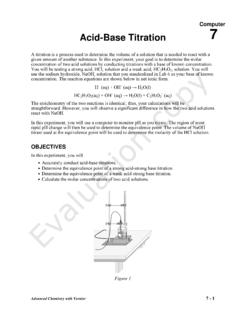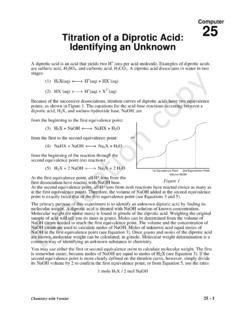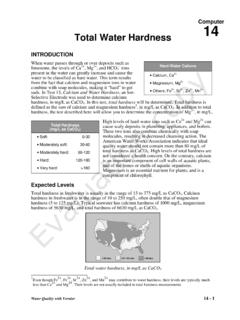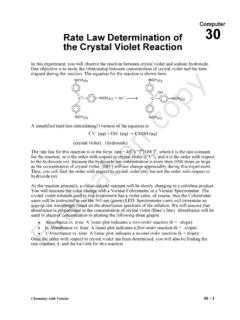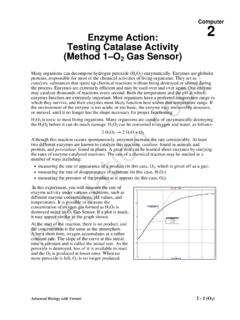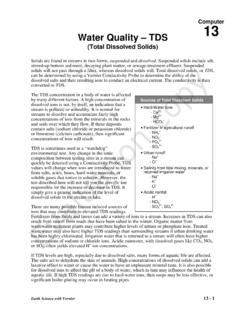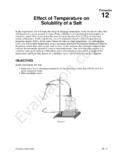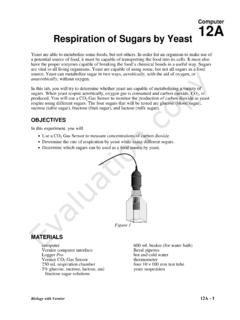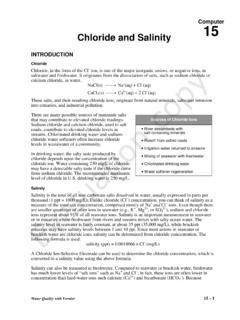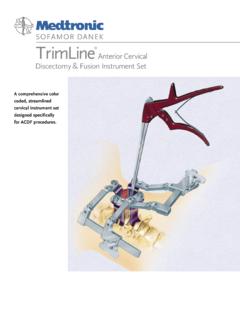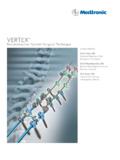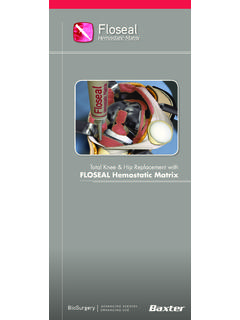Transcription of Computer 7 Phosphates copy Evaluation
1 Computer 7 Water Quality with Vernier 7 - 1 Phosphates ( ortho - and total) INTRODUCTION Phosphorus is an essential nutrient for all aquatic plants and algae. Only a very small amount is needed, however, so an excess of phosphorus can easily occur. Excess phosphorus is usually considered to be a pollutant because it can lead to eutrophication a condition where an overabundance of nutrients, such as phosphorus, causes increased plant and algal growth. Eutrophication can lower the levels of dissolved oxygen in the water and can render the water uninhabitable by many aquatic organisms. Phosphorus is often the limiting factor that determines the level of eutrophication that occurs.
2 Most phosphorus in surface water is present in the form of Phosphates . There are four classifications of Phosphates often referred to in environmental literature: orthophosphates are the inorganic forms of phosphate, such as PO43 , HPO42 , and H2PO4 . These are the forms of Phosphates used heavily in fertilizers and are often introduced to surface waters through runoff. organically bound Phosphates are found in human and animal wastes or in decaying organic matter. condensed Phosphates (also called polyphosphates), such as P3O105 , are sometimes added to water supplies and industrial processes to prevent the formation of scaling and to inhibit corrosion. This is the form of phosphate that was commonly found in detergents in the past. total Phosphates are the sum of all three of the forms described above. This is the most commonly reported form of phosphate concentration. Phosphates are added to surface waters by a variety of means. Humans add Phosphates to water through industrial and agricultural wastes.
3 Fertilizers contain high levels of Phosphates and will enter the water by means of runoff and soil erosion. In areas where land and vegetation have been disturbed, soil erosion will increase. This will lead to even more Phosphates being washed out of the soil and into the water. Phosphates can also come from the excrement of animals living in or near the water. Expected Levels The concentration of Phosphates will be expressed throughout this test in units of mg/L PO4-P, meaning phosphorus in the form of Levels above mg/L PO4-P can stimulate plant growth above its natural rate. Water that receives runoff from heavily fertilized areas may have higher levels of Phosphates . 1 Note that no charge is given to the PO4 when it is used in reporting phosphate units. Here it is being used as a generic symbol for many forms of Phosphates with varying charges, such as PO43 and HPO42 . Effects of Phosphate Levels High levels - eutrophication - increased algal blooms - increased BOD - decreased DO Low levels - limiting factor in plant and algal growth Sources of Phosphates Human and animal wastes Industrial wastes Agricultural runoff Human disturbance of land Evaluation copy Computer 7 7 - 2 Water Quality with Vernier A study by the Geological Survey, based on 410 sites throughout the United States, reports that in 1982, approximately 55% of the sites reported phosphate levels of greater than mg/L PO4-P.
4 By 1989, this percentage had dropped to close to 40%. This decline is due in part to the reduction of phosphorus content in detergents and Summary of Methods Both of the methods referred to below include procedures for determining levels of orthophosphates and total Phosphates . The only difference between methods is the number of standards used to create the standard curve. Orthophosphates are relatively easy to measure and will usually give a rough indication of the total level of Phosphates in the water. Orthophosphate concentration is determined by means of a chemical reaction resulting in a color change dependent on the concentration of orthophosphates present. The intensity of the color is then measured with a Vernier Colorimeter. The test for total Phosphates involves digesting, or treating the sample with an acid and an oxidizer, and boiling for 30 minutes to convert all the Phosphates into orthophosphates. The orthophosphate test is then conducted on the sample.
5 The results are reported as total Phosphates . This test is more involved than the orthophosphate test, but it is the form of Phosphates most commonly reported. Method 1: Phosphates Colorimeter with Single Standard A Vernier Colorimeter is used to create a 2-point standard curve of phosphate absorbance vs. concentration using a blank and one phosphate standard. This method is faster and easier than the multiple-standard method, but because your measurement depends upon one standard, the chances for error are somewhat higher. Method 2: Phosphates Colorimeter with Multiple Standards A Vernier Colorimeter is used to create a 4-point standard curve of phosphate absorbance vs. concentration using a set of four phosphate standards. This method takes more time and effort than the single-standard method, but the standard curve will be based on four points, reducing the chance of error. 2 Geological Survey, National Water Summary 1990 91, Hydrologic Events and Stream Water Quality, Water-Supply Paper 2400, United States Government Printing Office, 1993, 124 125.
6 Table 1: Phosphate Levels of Selected Rivers Site Total Phosphates (mg/L PO4-P) ortho - Phosphates (mg/L PO4-P) Missouri River, St. Joseph, MO Hudson River, Poughkeepsie, NY Missouri River, Garrison Dam, ND Rio Grande, El Paso, TX Willamette River, Portland, OR Phosphates Water Quality with Vernier 7 - 3 Method 1: Phosphates COLORIMETER WITH SINGLE STANDARD Materials Checklist ___ Computer ___ wash bottle filled with distilled water ___ Vernier Computer interface ___ tissues (preferably lint-free) ___ Logger Pro ___ Phosphate Standard ( mg/L PO4) ___ Vernier Colorimeter ___ PhosVer 3 Phosphate Powder Pillows ___ one cuvette ___ M HCl ___ sampling bottle ___ * M H2SO4 ___ 10 mL graduated cylinder ___ * M NaOH ___ 25 mL graduated cylinder ___ * hot plate ___ three 50 mL Erlenmeyer flasks ___ * Potassium Persulfate/Sulfate Powder Pillows * needed for total phosphate test only Collection and Storage of Samples Important: Phosphates can adhere to glass.
7 For best results all glassware involved in this test should be acid washed prior to use. To acid wash the glassware, soak in M HCl for 30 minutes, then rinse thoroughly with distilled water. CAUTION: Hydrochloric acid solution is very corrosive. It can cause painful burns if it comes in contact with the skin. 1. This test is best conducted in the lab. Collect 100 mL of water, so that multiple 25 mL tests can be conducted. 2. It is important to obtain the sample water from below the surface of the water and as far away from the shore as is safe. If suitable areas of the stream appear to be unreachable, samplers consisting of a rod and container can be constructed for collection. Refer to page Intro-4 of the Introduction of this book for more details. 3. If the testing cannot be conducted within a few hours, place the samples in an ice chest or a refrigerator. Testing Procedure 1. Obtain and wear goggles. 2. Label two Erlenmeyer flasks A and B.
8 3. Measure 25 mL of sample water into each flask using the 25 mL graduated cylinder. 4. Testing for total Phosphates or orthophosphates. a. If your instructor directs you to test for total Phosphates , go to the Data & Calculations sheet and check the Total box in the heading of Column C. Proceed to Step 5. b. If your instructor directs you to test for orthophosphates, go to the Data & Calculations sheet and check the ortho box in the heading of Column C. Proceed to Step 6. Computer 7 7 - 4 Water Quality with Vernier 5. Digest the water samples. Note: Perform this step only if you are testing for total Phosphates .
9 A. Add one Potassium Persulfate/Sulfate Powder Pillow to each flask and swirl. b. Add mL of M H2SO4 to each flask using the 10 mL graduated cylinder and swirl. CAUTION: Sulfuric acid, H2SO4, is very corrosive. Handle with care. c. Boil the samples for 30 minutes, adding small amounts of distilled water to keep the volume near, but not above 25 mL. CAUTION: Make sure you are boiling in a well-ventilated area. Do not breathe the fumes generated by this digestion. d. After the 30 minute digestion period, remove the flasks from the hot plate and allow the solutions to cool. e. Add mL of M NaOH to each of the flasks using the 10 mL graduated cylinder and swirl. CAUTION: Sodium hydroxide, NaOH, solution is caustic. Handle with care. f. If there is less than 25 mL of liquid in any flask, replenish the volume to 25 mL with distilled water. 6. Prepare the phosphate standard solution for use. a. Label the third Erlenmeyer flask with an S for standard and add 25 mL of mg/L Phosphate Standard.
10 B. Add a PhosVer 3 Phosphate Powder Pillow to the flask. c. Swirl the solution until the powder is mostly dissolved. d. Continue with the testing procedure while the reaction takes place. It will take two minutes for a complete reaction to occur. 7. Position the Computer safely away from the water. Keep water away from the Computer at all times. 8. Plug the Colorimeter into Channel 1 of the Vernier interface. 9. Prepare the Computer for data collection by opening the file 07 Phosphates from the Water Quality with Vernier experiment files of Logger Pro. 10. Prepare a blank by filling an empty cuvette 3/4 full with distilled water. Seal the cuvette with a lid. To correctly use a colorimeter cuvette, remember: All cuvettes should be wiped clean and dry on the outside with a tissue. Handle cuvettes only by the top edge of the ribbed sides. All solutions should be free of bubbles. Always position the cuvette with its reference mark facing toward the white reference mark at the top of the cuvette slot on the colorimeter.
